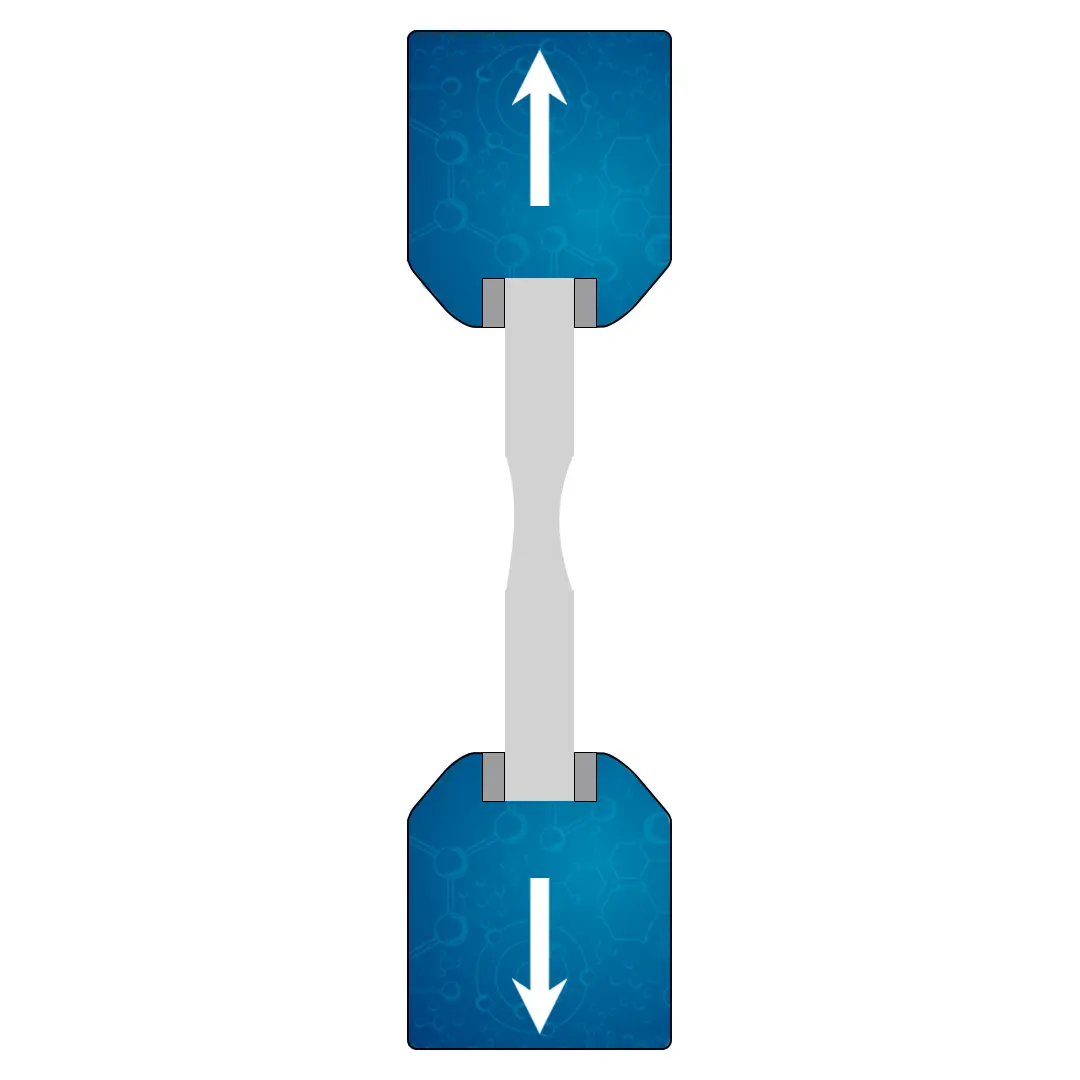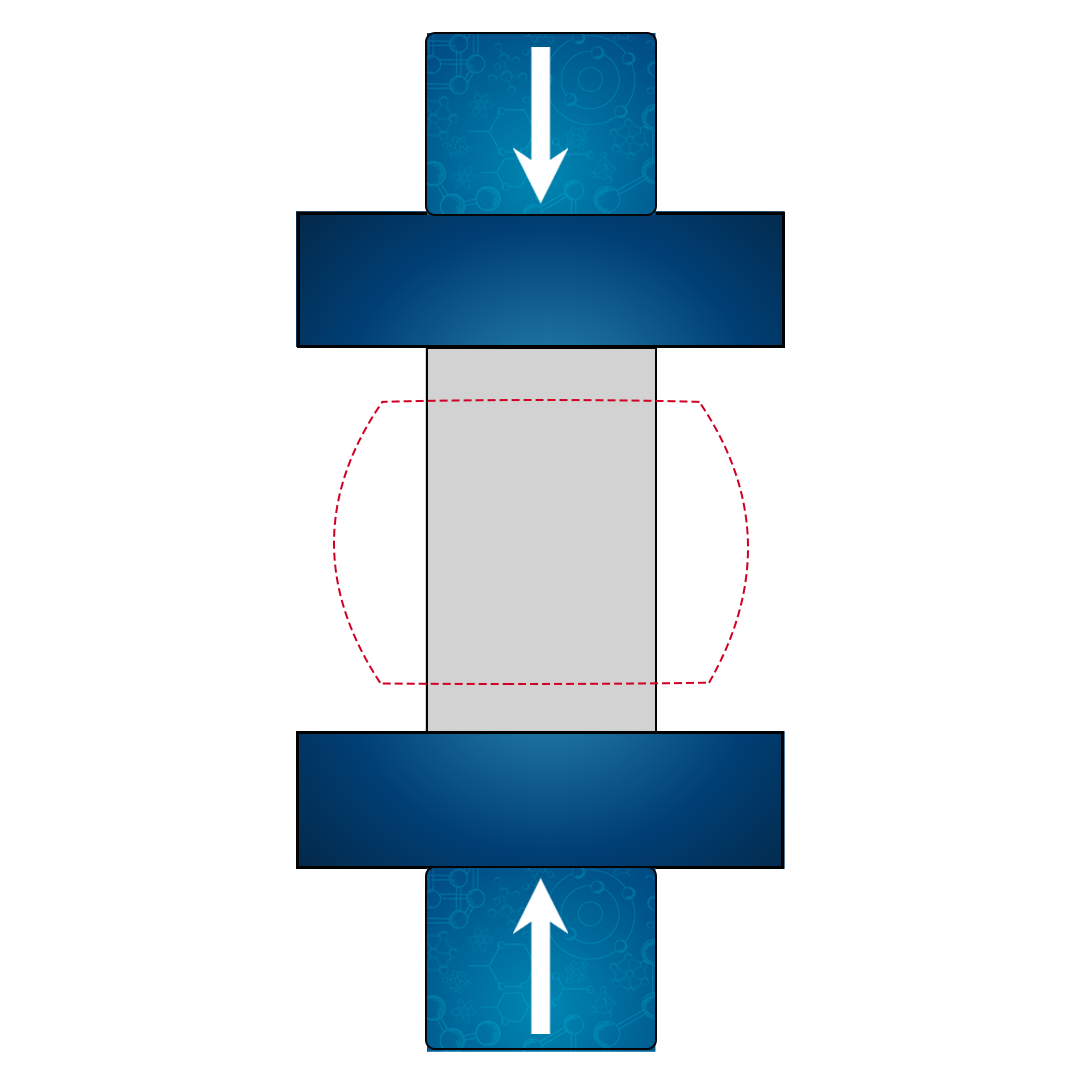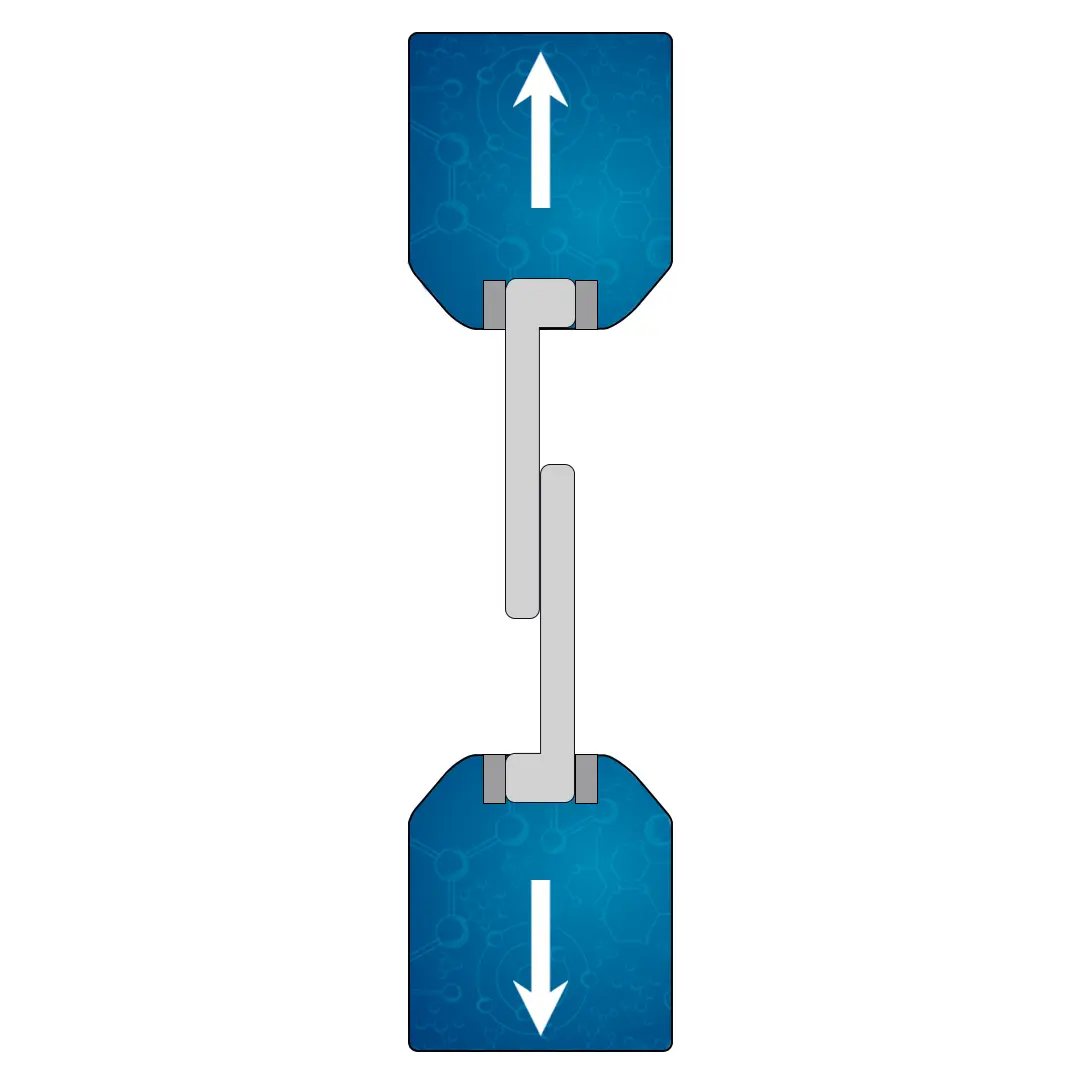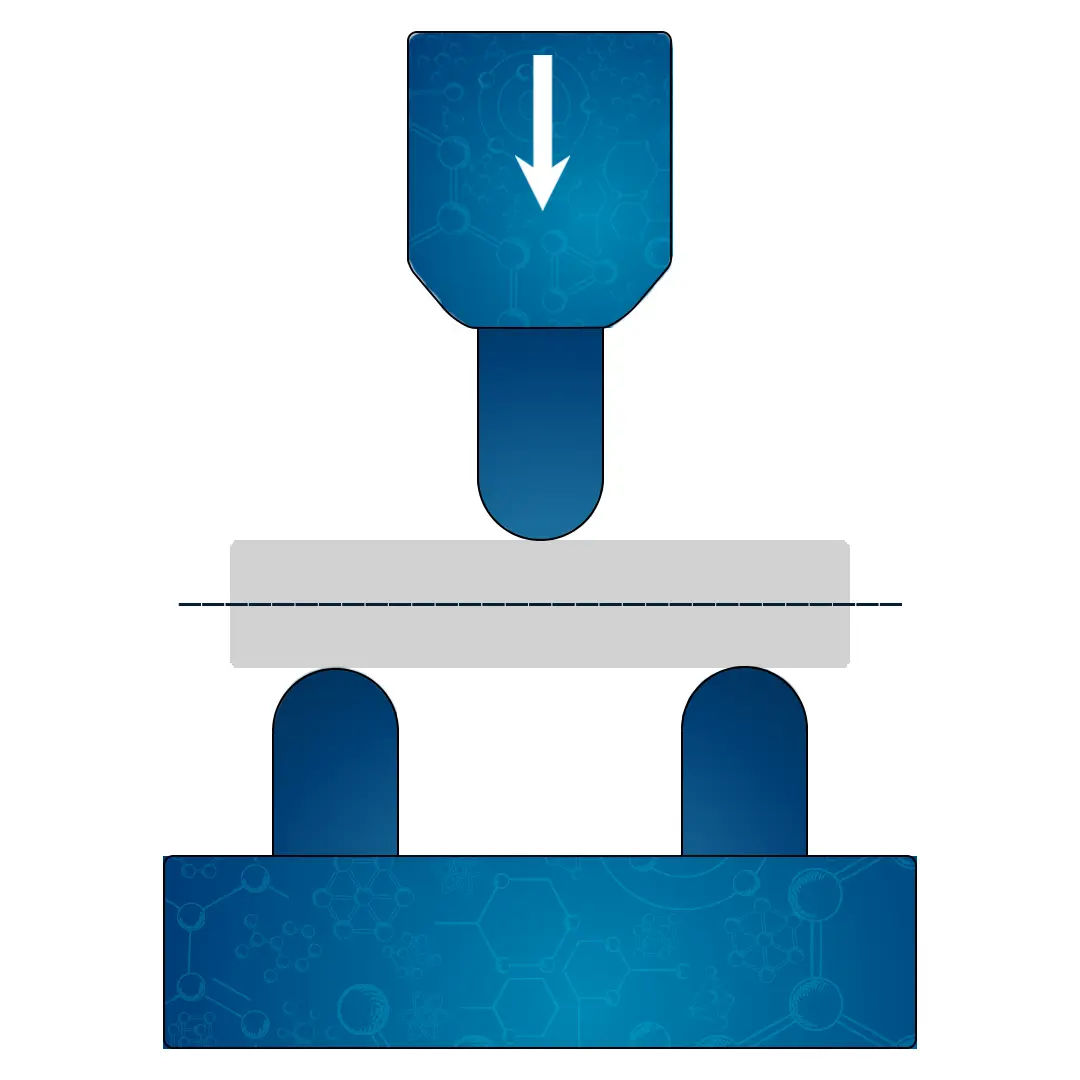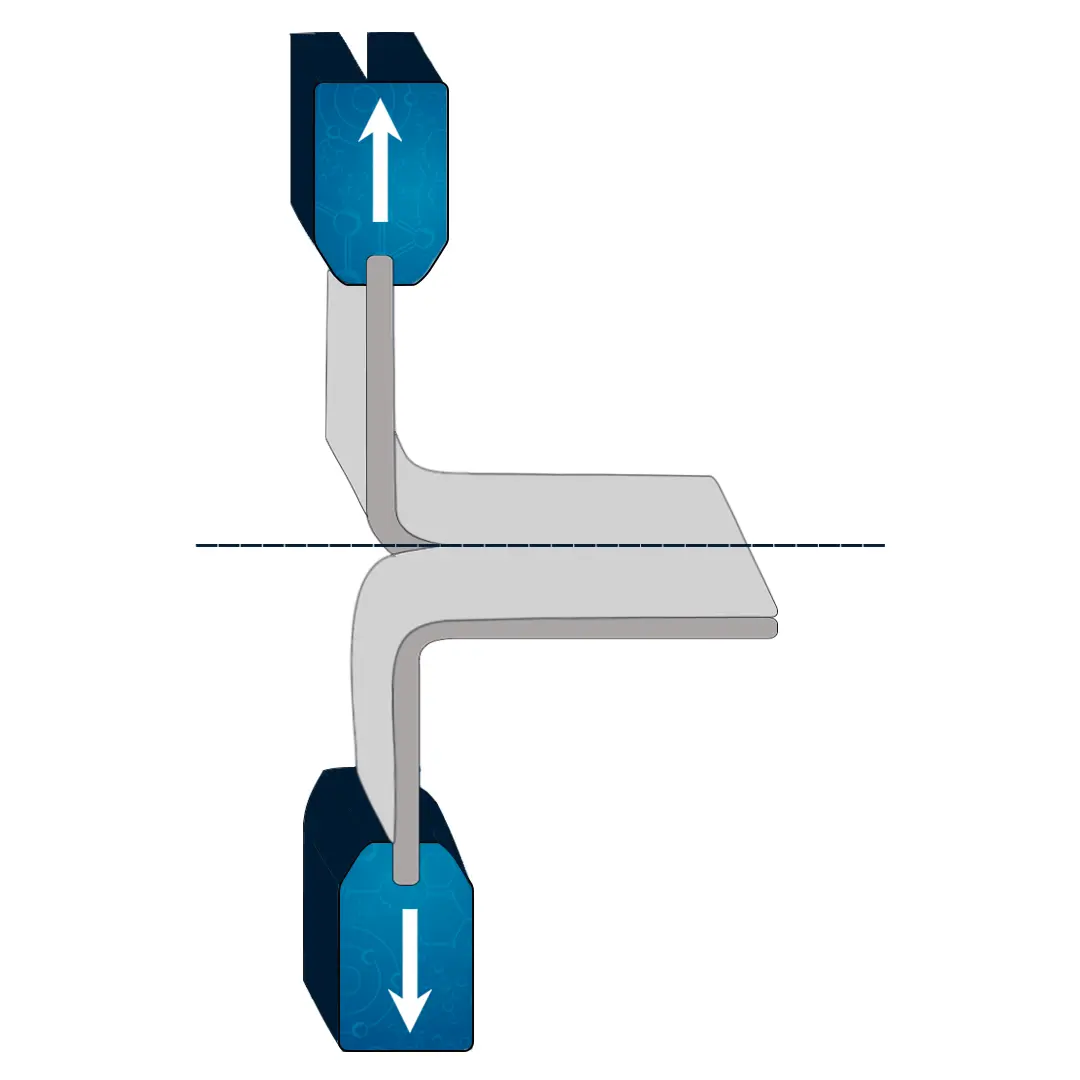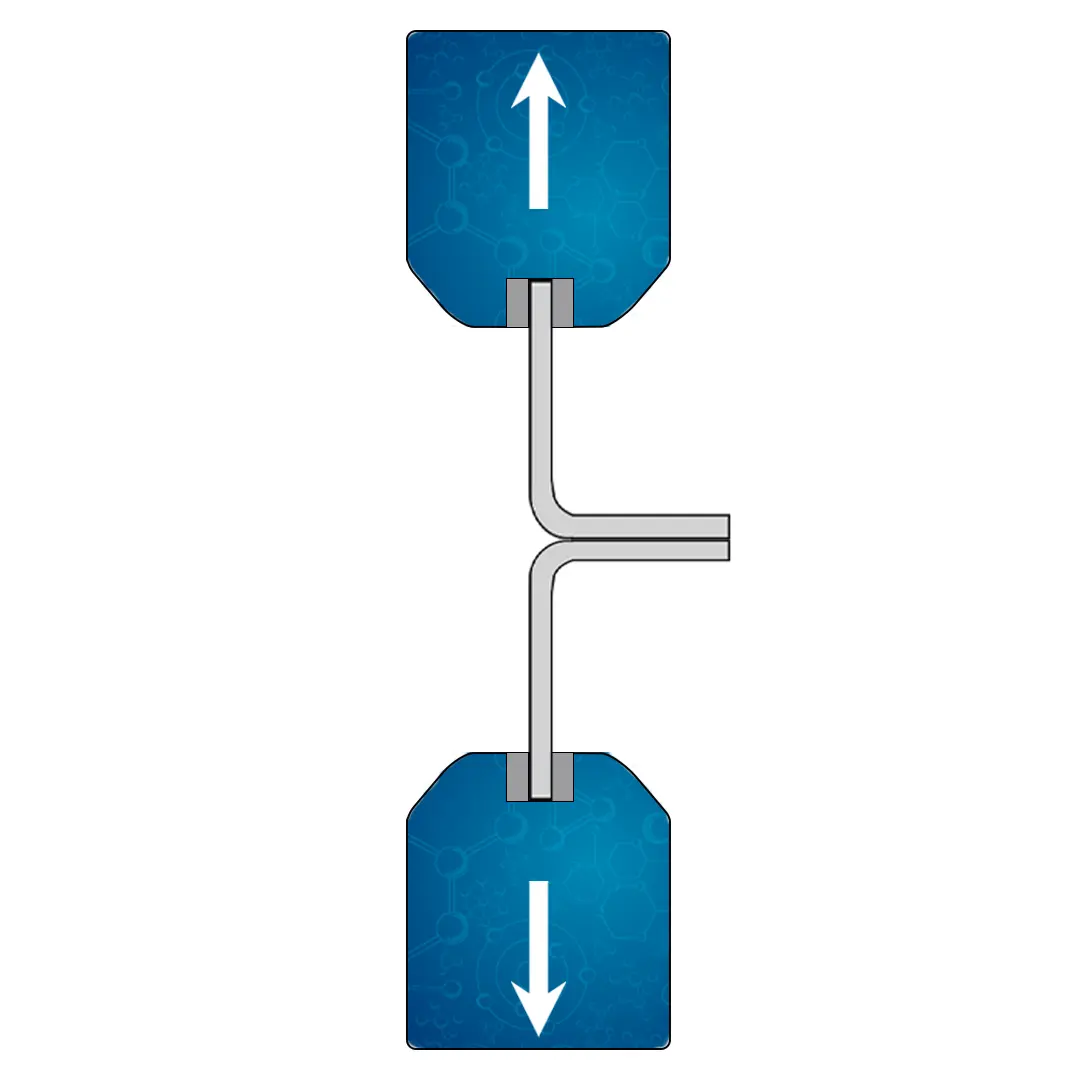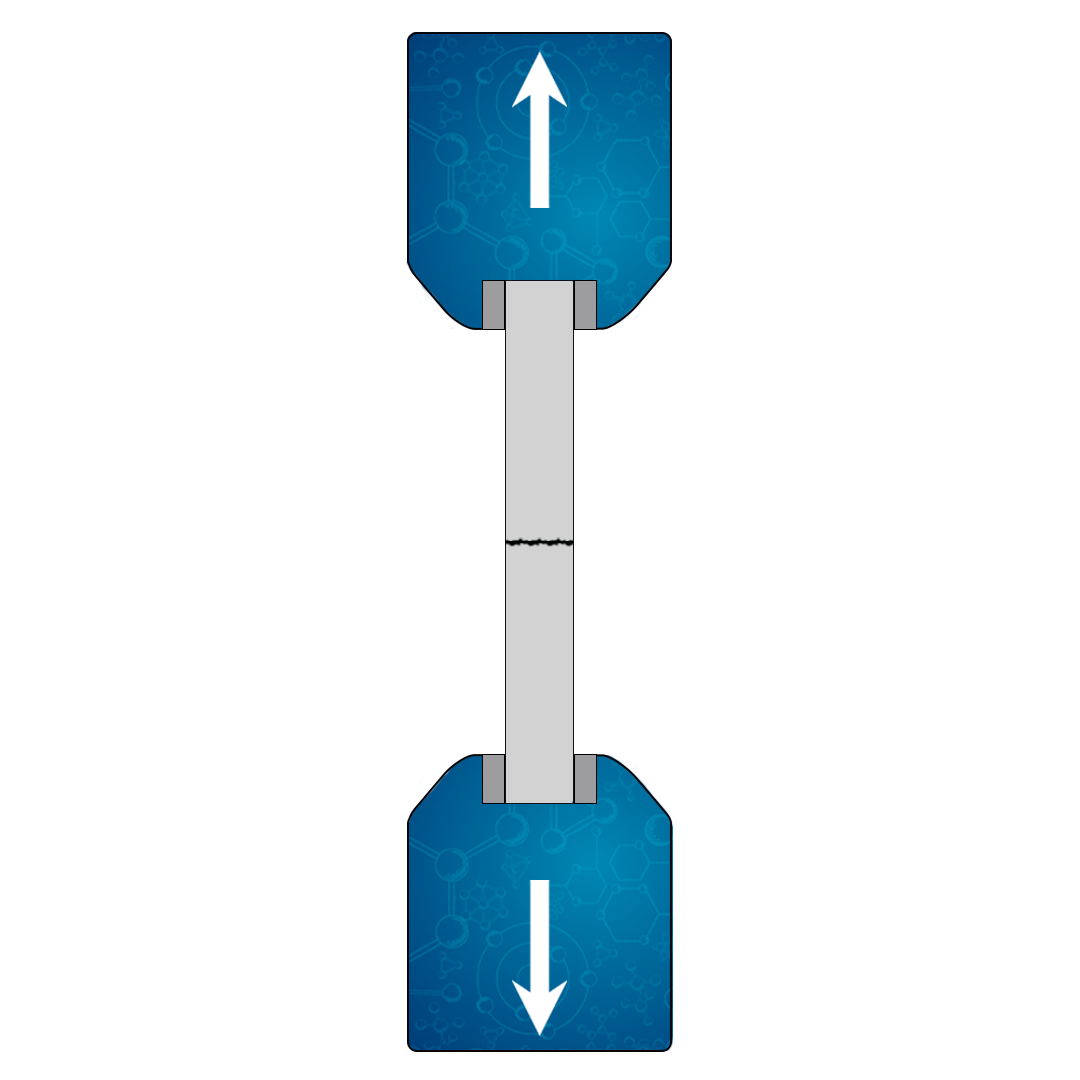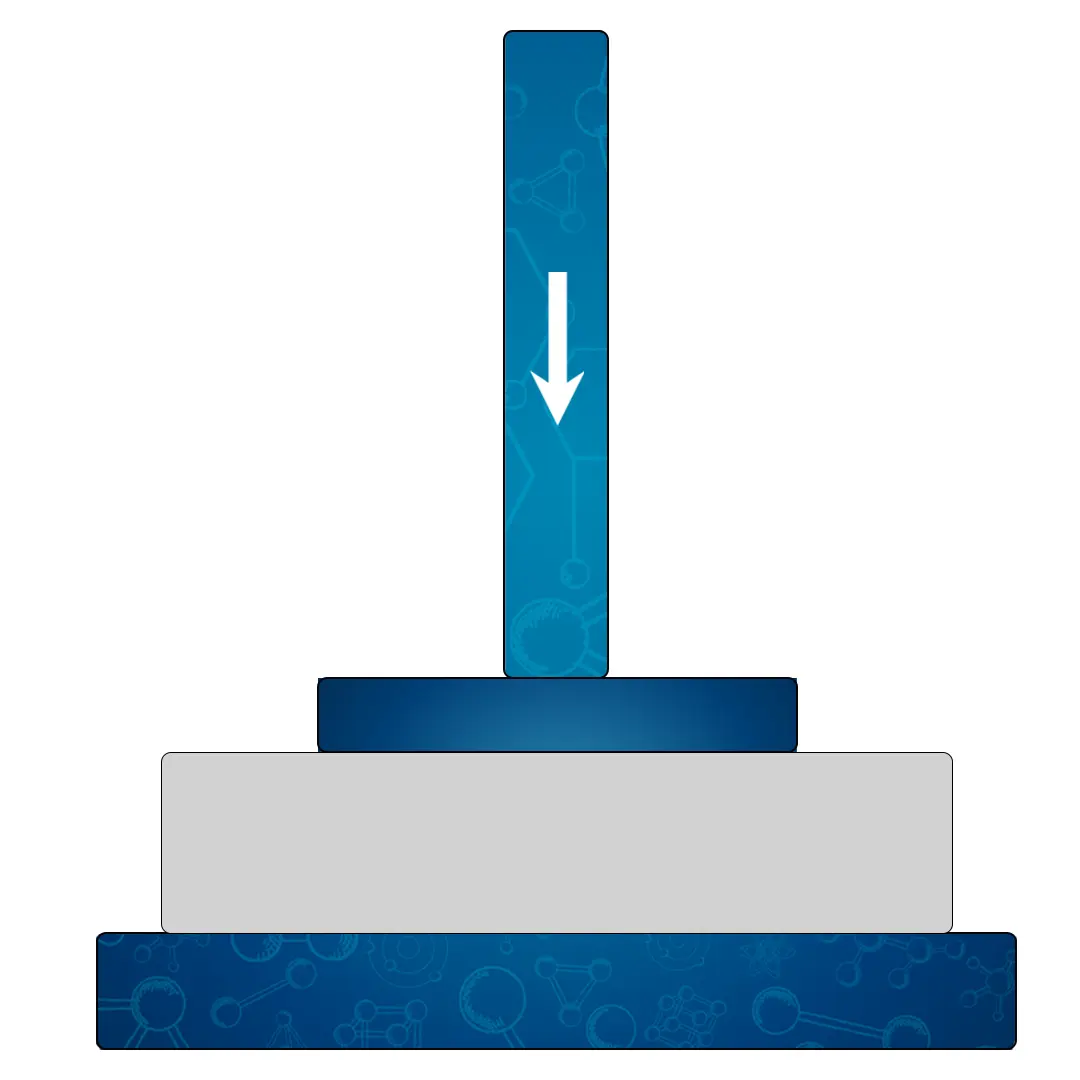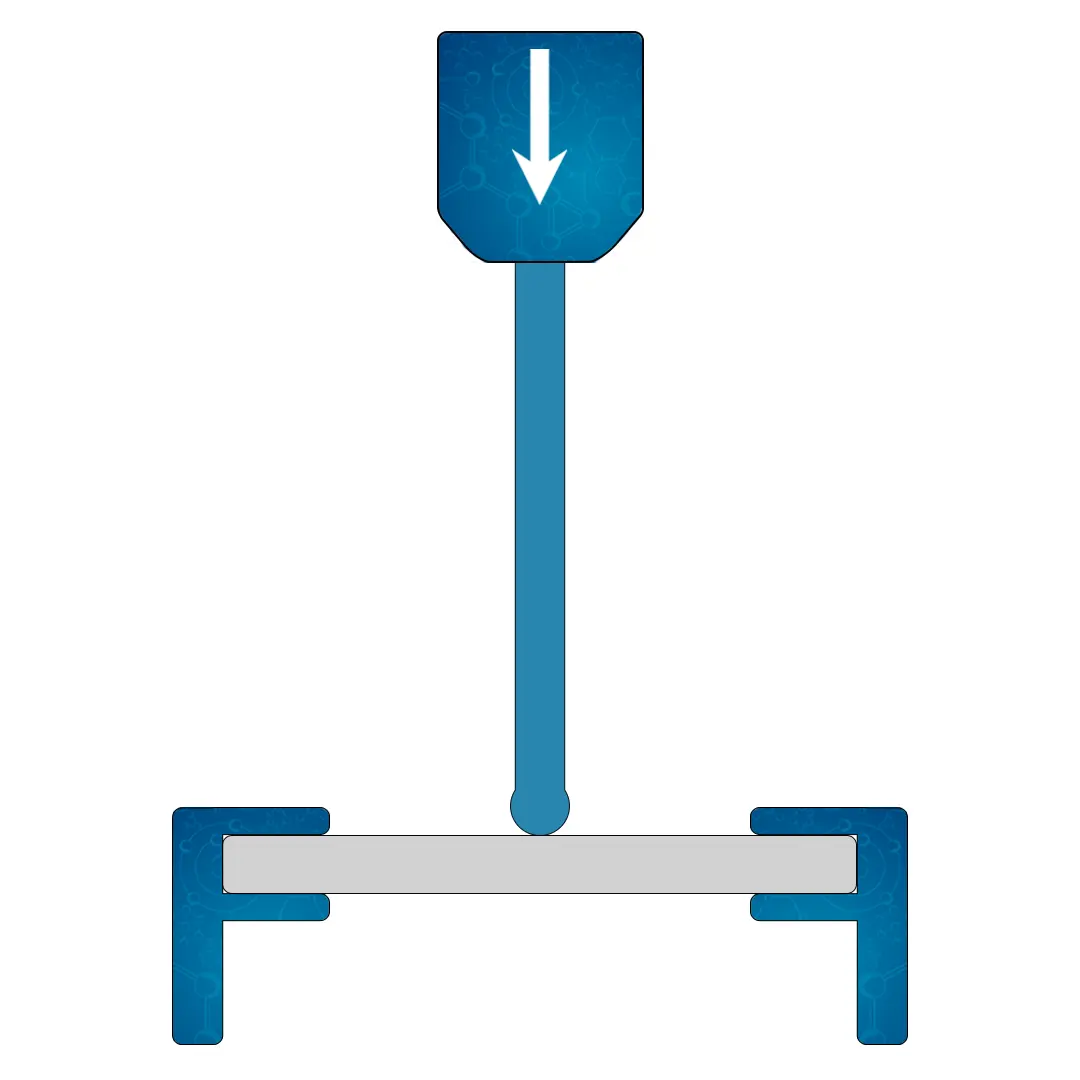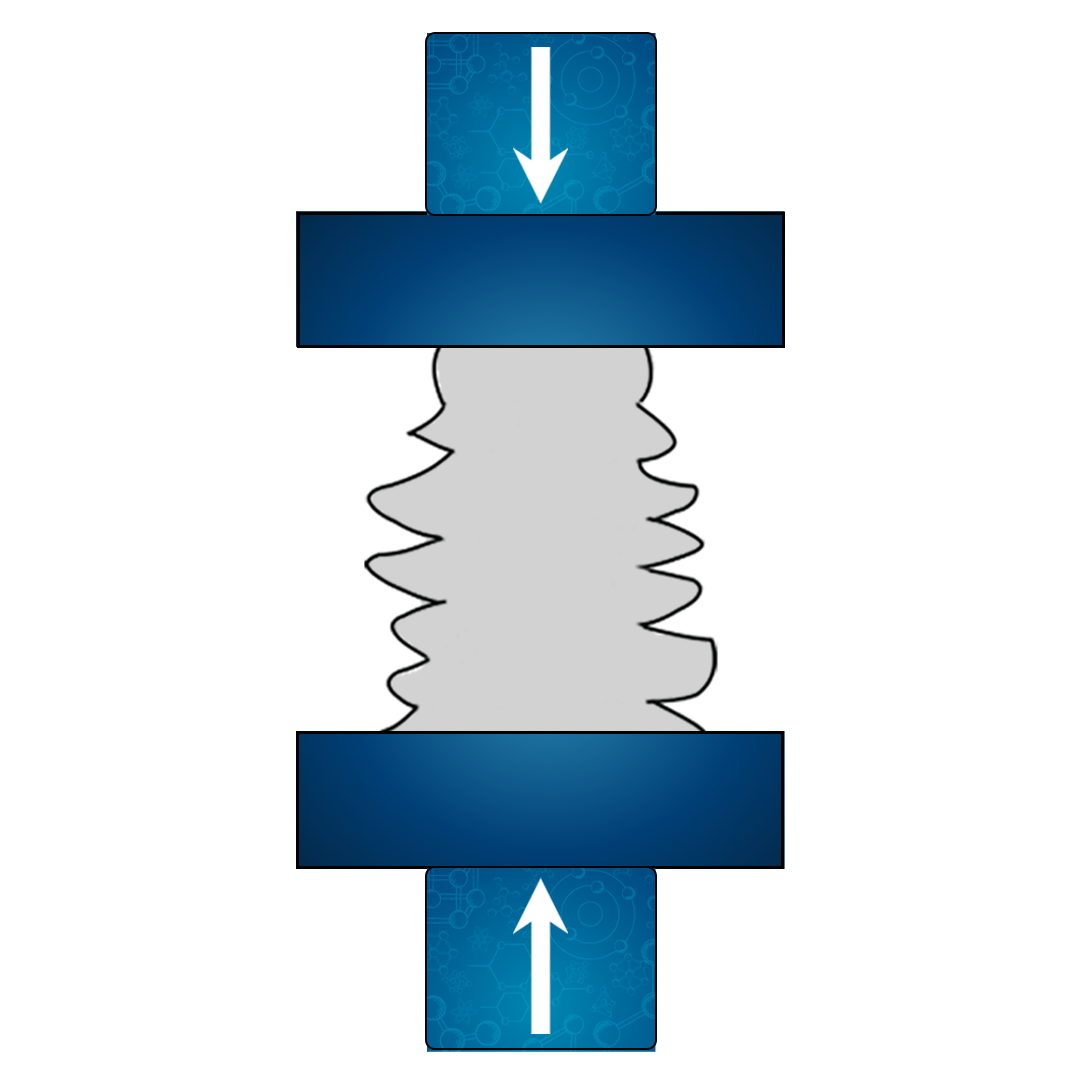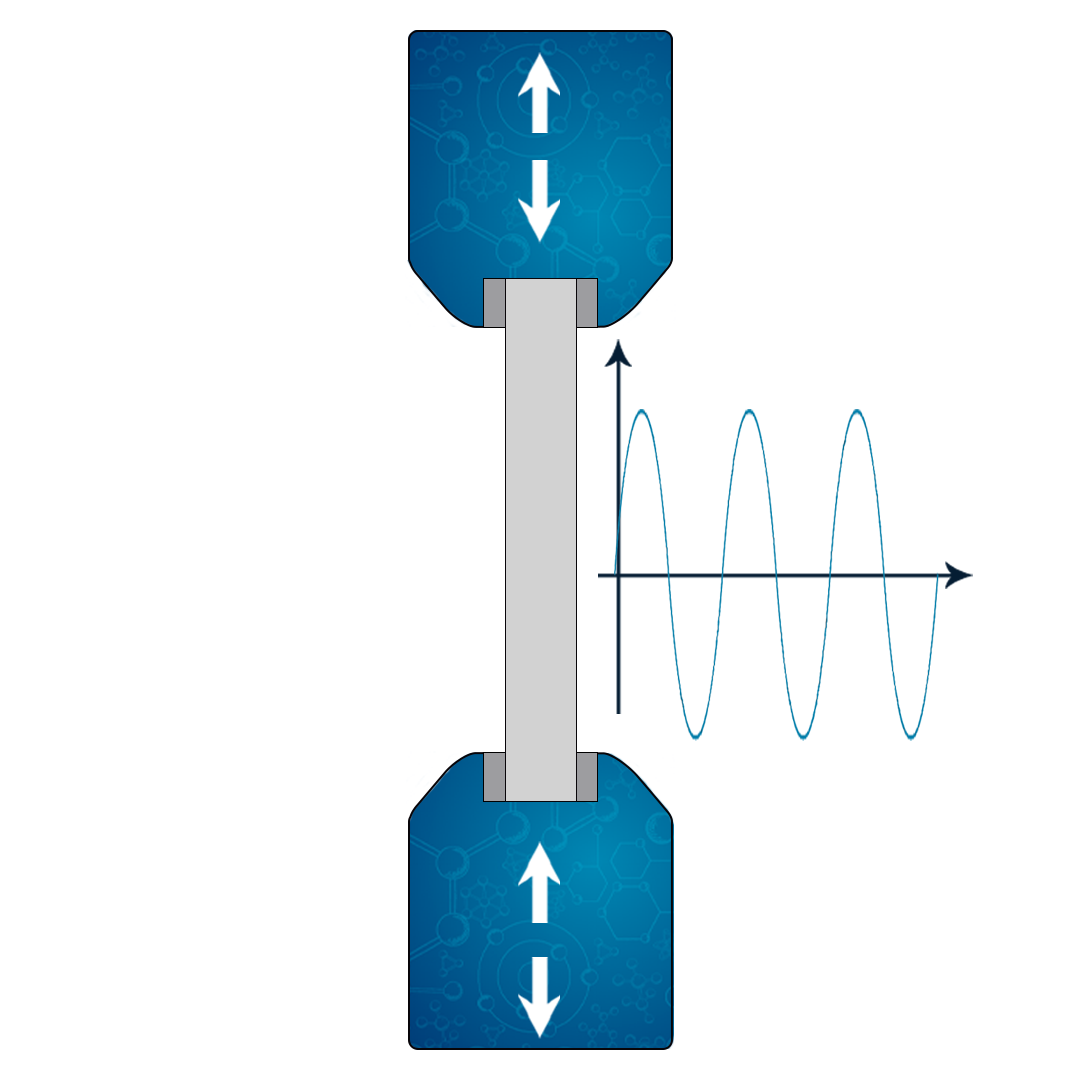Tensile testing – complete guide to testing metals, polymers and composite materials.
This comprehensive guide delves into the fundamental concept of tensile testing, a crucial mechanical test that determines the strength and ductility of materials. It explores the importance, calculation, and advantages of tensile testing, along with the properties and purposes it serves in various materials like metals, polymers, ceramics, and composites.
The article also details the use of a Tensile Testing Machine in conducting tensile tests, the procedures involved, and the data obtained. Finally, it provides an overview of the main ISO and ASTM standards for tensile testing and its key applications across industries.
In the following text, you will find a summary of the topics that will be addressed in this article.
What is the tensile testing?
The tensile testing consists of the application of an axial tensile force in a standardized specimen, promoting the deformation of the material in the direction of the effort, which tends to elongate it until fracture. Due to the ease of execution and reproducibility of the results, this test is widely used.
The results of the tensile test, often plotted on a stress-strain curve, provide key properties such as the material’s yield strength, ultimate tensile strength, modulus of elasticity, and elongation at break. This information is crucial in material selection, quality control, and structural design.
The Stress, which is expressed in megapascals (Mpa), Newton per square millimeter (N / mm2) or in kilogram per square millimeter (Kg / mm2), is calculated by dividing the applied force (F) by the original cross-sectional area (A0) of the specimen.
The Strain is the deformation experienced by the material in response to stress. It’s calculated by dividing the change in length (ΔL) by the original length (L0) of the specimen. Strain is a dimensionless quantity.
In a Tensile testing machine, designed for this type of testing, data is obtained and computed throughout the process, thus allowing for further analysis of the information regarding the material used.
Video about Tensile testing
Representation of a tensile testing
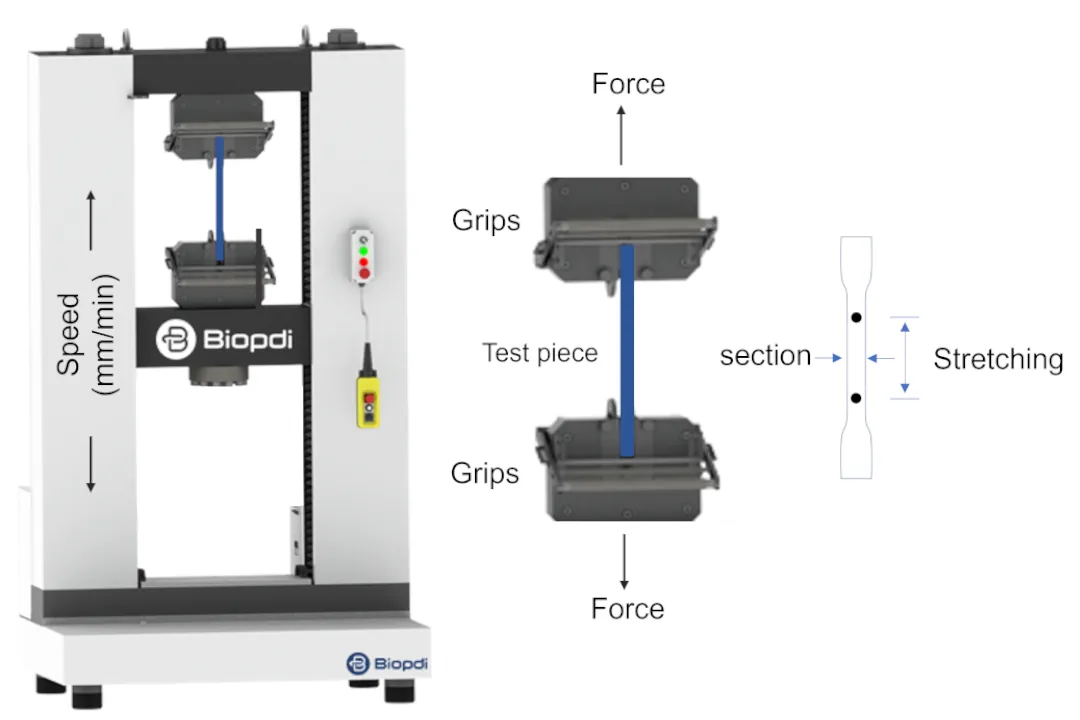
Figure 1 – Representation of a tensile testing
Why perform a tensile testing?
Tensile testing plays a crucial role in materials science and engineering for several reasons:
- Material Characterization: Tensile testing is used to characterize the mechanical properties of a material, including its yield strength, ultimate tensile strength, modulus of elasticity, and ductility. This information is crucial for understanding how a material will behave under different types of stress and strain.
- Quality Control: Tensile testing is a standard part of the quality control process in manufacturing industries. It ensures that a material or product meets the necessary standards and specifications, and it can help identify issues with a product’s quality or performance.
- Material Selection: By providing detailed information about a material’s strength, ductility, and elasticity, tensile testing helps engineers and designers select the most appropriate materials for a specific application. For example, a material with high tensile strength might be chosen for a component that needs to withstand significant stress.
- Product Development: Tensile testing can be used in the product development process to compare the performance of different materials or designs. This can lead to improvements in the product’s performance or durability.
- Predicting Material Behavior: The data obtained from tensile testing can be used to predict how a material will behave under different types of loads and conditions. This is particularly important in fields like construction and aerospace, where understanding the material’s behavior under stress can prevent failures and accidents.
- Research and Development: In materials science research, tensile testing is often used to study new materials or to understand the properties of existing materials better. This can lead to the development of new materials with improved properties.
- Compliance with Regulations: Many industries have regulations requiring materials to meet certain tensile strength standards. Tensile testing ensures compliance with these regulations, helping to avoid legal issues and ensuring the safety of the end product.
In summary, tensile testing is a vital tool in the field of materials science and engineering. It provides valuable information about a material’s mechanical properties, helping to ensure the safety, reliability, and performance of a wide range of products and applications.
What are the advantages of using the tensile testing?
Tensile testing offers several advantages in the field of materials science and engineering:
- Comprehensive Information: Tensile testing provides a wealth of information about a material’s mechanical properties, including its yield strength, ultimate tensile strength, elasticity, and ductility. This data is crucial for understanding how a material will behave under different types of stress and strain.
- Versatility: Tensile tests can be performed on a wide range of materials, including metals, plastics, ceramics, composites, and even fibers. This makes it a versatile tool in materials testing.
- Standardization: Tensile testing procedures are standardized across industries, which means that results from different labs can be compared directly. This is particularly important for quality control and material selection.
- Predictive Capabilities: The data obtained from tensile testing can be used to predict how a material will behave under real-world conditions. This can help prevent material failure and improve product safety and performance.
- Cost-Effective: Tensile testing is a relatively inexpensive way to determine a material’s mechanical properties. The equipment required for tensile testing is widely available and not overly complex, which contributes to its cost-effectiveness.
- Ease of Use: Tensile tests are relatively easy to perform, and the results are straightforward to interpret. This makes tensile testing a practical option for routine testing and quality control.
In conclusion, tensile testing is a valuable tool in materials science and engineering. It provides essential data about a material’s mechanical properties, helping to ensure the safety, performance, and reliability of a wide range of products and applications.
Classification of Tensile Tests According to the Time-Dependent Load Progression
Tensile testing can be differentiated according to the temporal progression of the load, which refers to how the load is applied over time. There are three main types of tensile tests based on this criterion: static, dynamic, and fatigue.
- Static Tensile Test: In a static tensile test, the load is applied slowly and steadily over a long period of time. The rate of loading is slow enough that the material has time to fully respond to the applied stress, and the strain in the material is directly proportional to the applied stress. This type of test is used to determine the elastic modulus, yield strength, and ultimate tensile strength of the material.
- Dynamic Tensile Test: In a dynamic tensile test, the load is applied rapidly. The rate of loading is fast enough that the material does not have time to fully respond to the applied stress. This type of test is used to determine the material’s response under high strain rates, which can be important in applications such as impact or crash scenarios. The material’s behavior under dynamic loading can be significantly different from its behavior under static loading.
- Fatigue Tensile Test: In a fatigue tensile test, a cyclic load is applied to the material. The load varies between a minimum and maximum value, typically with a sinusoidal waveform. This type of test is used to determine the material’s fatigue life, which is the number of load cycles the material can withstand before failure. Fatigue testing is important in applications where the material is subjected to repeated loading, such as in an aircraft wing or a car suspension component.
Each of these tests provides different information about the material’s mechanical properties and can be used to predict the material’s behavior under different types of loading conditions. The choice of test depends on the specific application and the type of loading the material is expected to experience in service.
Tensile testing for metallic materials
As one of the most frequently used tests in the industry, the tensile test evaluates several mechanical properties of materials. These properties are derived from the analysis of a graph generated by the test, known as the stress-strain curve. This curve is instrumental in complementing the mathematical analysis involved in the process.
The stress-strain curve of metallic materials allows us to describe all the crucial parameters in the test. Below, we delve into a better understanding of these parameters, which become evident when the material is subjected to mechanical stresses. These parameters determine the material’s capacity to transmit or resist the stresses applied to it.
The stress-strain curve is a graphical representation of the relationship between stress – the force per unit area on an object, and strain – the deformation caused by the stress. The stress-strain curve has several key regions and points of interest.
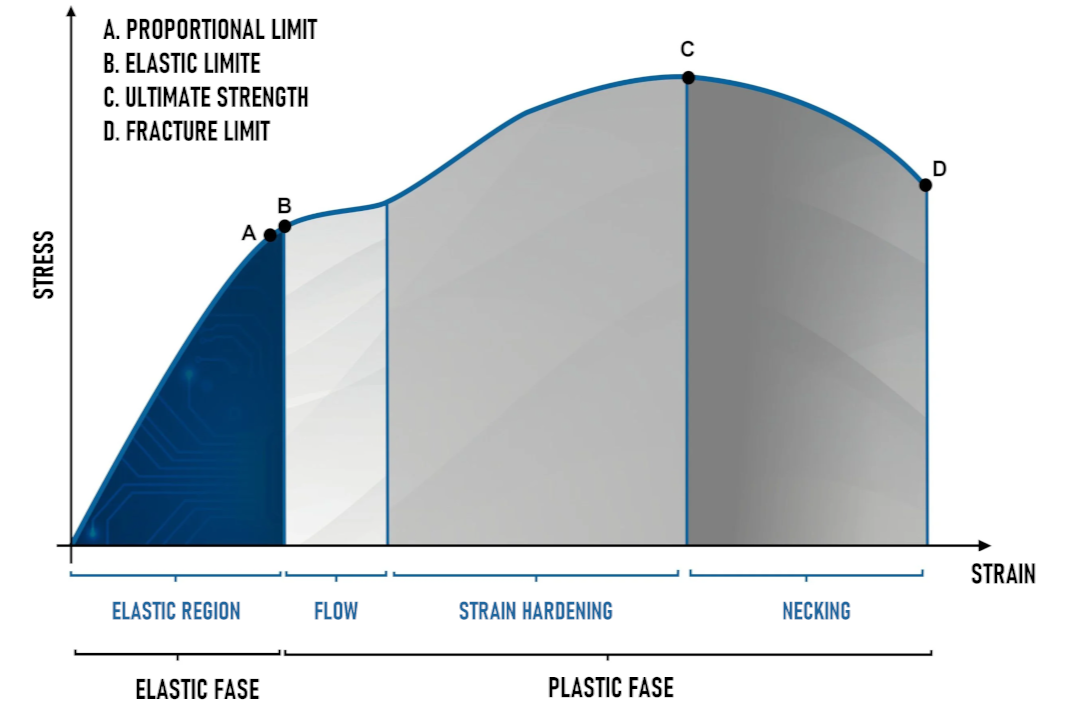
Figure 2 – Typical stress-strain curve of a tensile test
The stress-strain curve for mild steel, a ductile material, is a graphical representation of the relationship between stress, derived from applied force, and strain, or deformation, resulting from the stress. The curve is divided into several distinct regions, each representing different material behavior under stress. Here’s a detailed explanation of each region and the properties derived from it:
Stress: Stress is a measure of the internal forces that a material experiences when a load is applied. It’s calculated by dividing the applied force (F) by the original cross-sectional area (A0) of the material. Stress is typically measured in units of pressure such as Pascals (Pa) or pounds per square inch (psi). The formula is:
σ = F / A0
This calculation assumes that the force is distributed evenly across the area. If the force is not uniform, the stress at any given point may be higher or lower than the average stress given by this formula.
Strain: Strain measures how much a material deforms in response to stress. It’s calculated by dividing the change in length (ΔL) by the original length (L0) of the material. The formula is:
ε = ΔL / L0
This calculation assumes that the deformation is uniform along the length of the material. If the deformation is not uniform, the strain at any given point may be higher or lower than the average strain given by this formula.
Proportional Limit (Elastic Region): This is the initial linear portion of the curve, where the material behaves elastically and deformation is temporary. If the stress is removed during this phase, the material will return to its original shape. The slope of this region is known as the Modulus of Elasticity or Young’s Modulus (E), which measures the material’s stiffness. The end of this linear region is known as the Proportional Limit.
Elastic Limit: Just beyond the proportional limit is the elastic limit. Up to this point, the material will still return to its original shape when the stress is removed. Beyond this point, permanent deformation occurs.
Yield Point: The yield point marks the end of the elastic region and the beginning of the plastic region. It’s the point at which the material will undergo permanent deformation and won’t return to its original shape when the stress is removed. The stress at the yield point is called the Yield Strength (σy).
Strain Hardening (Plastic Region): Beyond the yield point, the material will continue to deform even with no increase (or even a decrease) in load. This region is characterized by work hardening, where the material strengthens due to plastic deformation. This region ends at the Ultimate Tensile Strength point.
Ultimate Tensile Strength (UTS): This is the maximum stress that the material can withstand before necking (localized deformation) occurs. It’s the highest point on the stress-strain curve.
Necking Region: Beyond the UTS, the material undergoes necking, where it starts to thin and weaken at a particular point, leading to a decrease in the engineering stress (force/original area). However, the actual or true stress on the material continues to increase due to the reduced area at the neck.
Fracture Point: The point at which the material finally breaks or fractures is the fracture point. The stress at this point is the fracture stress.
Elastic Phase: The elastic phase is the portion of the stress-strain curve where the material will return to its original shape when the stress is removed. This phase is characterized by a linear relationship between stress and strain, as described by Hooke’s Law.
Plastic Phase: The plastic phase is the portion of the stress-strain curve where the material will undergo permanent deformation when the stress is removed. This phase is characterized by a non-linear relationship between stress and strain.
Hooke’s Law: Hooke’s Law states that the stress applied to a material is directly proportional to the strain it experiences, as long as the stress does not exceed the material’s elastic limit.
Hooke’s Law can be stated as follows:
F = -k * x
Where:
- F is the force applied to the material,
- k is a constant specific to the material known as the spring constant,
- x is the displacement of the material (the amount it has been stretched or compressed from its original position).
The negative sign indicates that the force exerted by the spring is in the opposite direction to its displacement.
In the context of tensile testing and stress-strain relationships, Hooke’s Law is often expressed as:
σ = E * ε
Where:
- σ is the applied stress,
- E is the modulus of elasticity (also known as Young’s modulus), a constant that describes the material’s stiffness,
- ε is the strain, or deformation per unit length.
This version of Hooke’s Law states that the strain in a material is proportional to the applied stress, with the constant of proportionality being the modulus of elasticity. This relationship holds as long as the stress is within the elastic limit of the material. Beyond the elastic limit, the material may undergo plastic deformation and Hooke’s Law no longer applies.
Modulus of Elasticity (Young’s Modulus): The modulus of elasticity, or Young’s modulus is a measure of a material’s stiffness. It’s calculated by dividing the stress (σ) by the strain (ε) in the elastic (linear) region of the stress-strain curve. The formula is:
E = σ / ε
This calculation assumes that the material obeys Hooke’s Law and that the stress-strain relationship is linear in the region of interest. If the material does not obey Hooke’s Law, or if the stress-strain relationship is nonlinear, the modulus of elasticity may vary with stress and strain.
Poisson’s Ratio: Poisson’s ratio measures how much a material tends to contract (or expand) in one direction when it is stretched (or compressed) in another direction. It’s calculated by taking the negative ratio of transverse strain (εt, the strain in the direction perpendicular to the applied stress) to longitudinal strain (εl, the strain in the direction of the applied stress). The formula is:
ν = – εt / εl
This calculation assumes that the material is isotropic (its properties are the same in all directions) and that the strains are small. If the material is anisotropic, or if the strains are large, Poisson’s ratio may vary with direction and magnitude of strain.
Modulus of Resilience: The modulus of resilience is a measure of a material’s ability to absorb energy when it is deformed elastically, and then to return that energy when the load is removed. It is the area under the elastic portion of the stress-strain curve.
Necking or Area Reduction: Necking is a form of tensile deformation where relatively large amounts of strain localize disproportionately in a small region of the material. The cross-sectional area of the material decreases in the necked region, leading to eventual fracture.
Modulus of Toughness: The modulus of toughness is a measure of a material’s ability to absorb energy up to fracture. It is the total area under the stress-strain curve up to the point of fracture. For ductile materials, this includes both the elastic and plastic regions of the curve. For brittle materials, which have little to no plastic deformation before fracture, the modulus of toughness is often equivalent to the modulus of resilience.
In the following figure shows the typical tensile test for ductile and brittle materials, with ductile materials tending to have a large plastic deformation, with stricter occurring in the test piece during the test, this is the case of copper, low carbon steels or steel. In the case of brittle materials, little or no plastic deformation occurs, as the material stores all the energy applied to deform it and fractures catastrophically, this occurs with gray cast iron, tempered steel and ceramic materials.
The shape and magnitude of a metal stress-strain curve depend on its composition, heat treatment, previous history of plastic strain and the strain rate, temperature, and tension state imposed during the test.
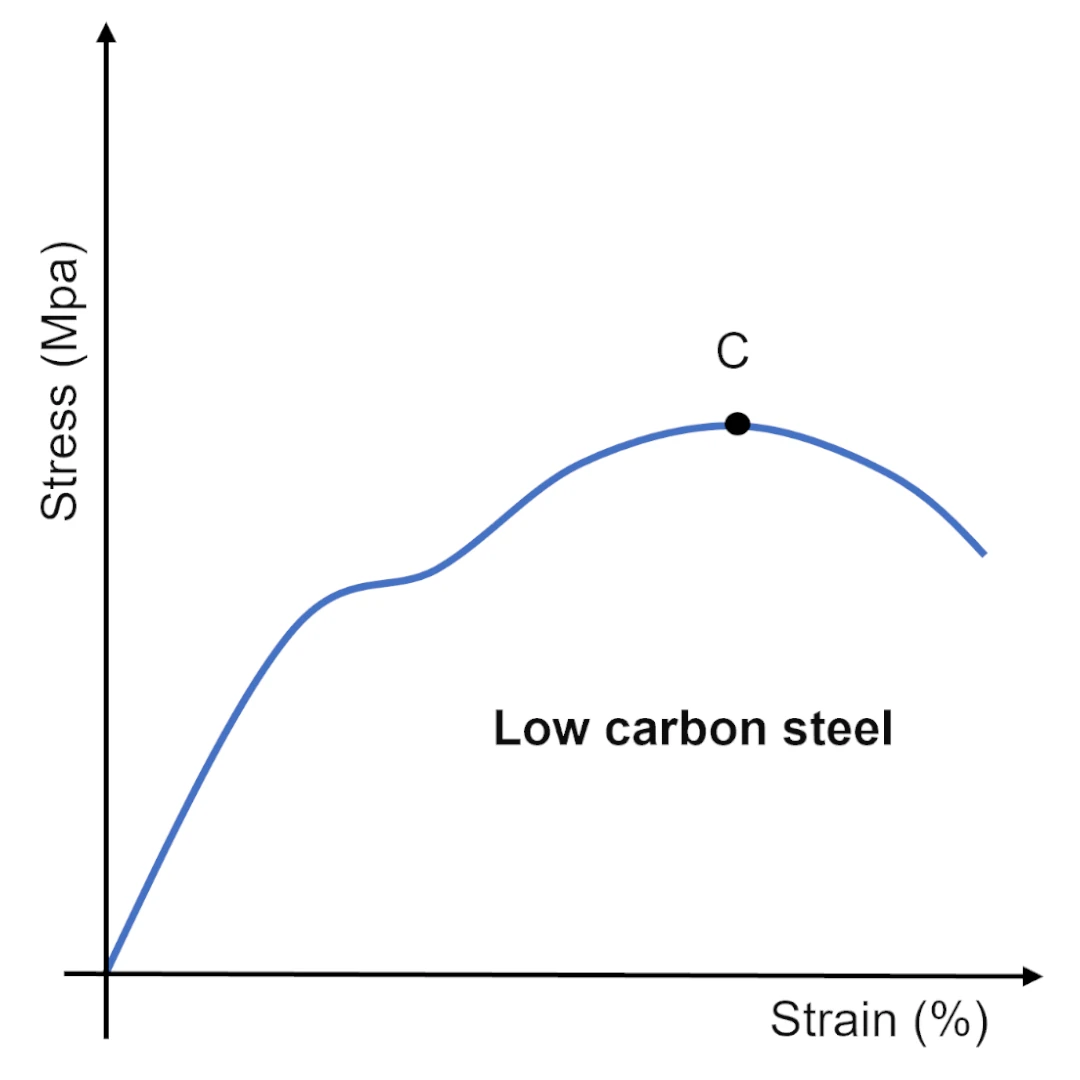
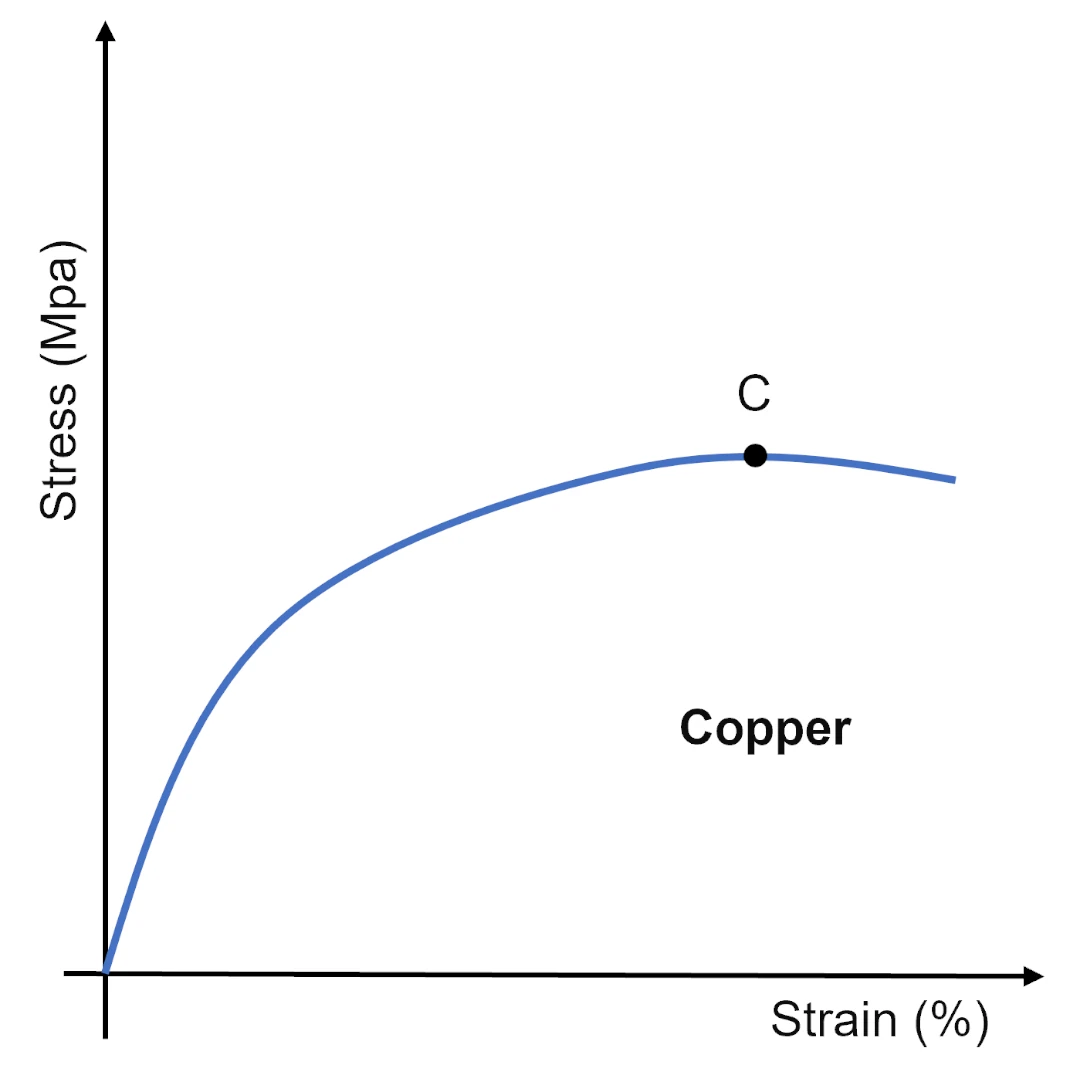

Figure 3 – Typical stress-strain curve of low carbon steel, copper and gray cast iron
Tensile tests are conducted on a variety of materials including metals and alloys. Here are some common metallic materials and their typical tensile testing values:
- Steel: Steel is one of the most commonly used metals in the world, with a wide range of applications. The tensile strength of steel can vary greatly based on its type and treatment, but generally, it falls between 400-500 MPa for mild steel. High-strength, low-alloy steels can have tensile strengths up to 800 MPa.
- Aluminum: Aluminum is a lightweight, ductile metal. The tensile strength of pure aluminum is around 90-100 MPa, but aluminum alloys can have tensile strengths ranging from 200 MPa to 600 MPa.
- Copper: Copper is known for its excellent electrical conductivity. The tensile strength of copper is approximately 210-220 MPa. Copper alloys, such as bronze and brass, have higher tensile strengths, often exceeding 400 MPa.
- Titanium: Titanium is a strong, lightweight metal often used in aerospace applications. Commercially pure titanium has a tensile strength of about 240-370 MPa, while titanium alloys can have tensile strengths over 1000 MPa.
- Nickel: Nickel has a tensile strength of around 460-1400 MPa. Nickel-based superalloys, which are used in high-temperature applications like jet engines, can have tensile strengths over 1000 MPa.
These are approximate values. The actual tensile strength can vary based on factors such as the specific alloy used, the manufacturing process, and any heat treatment or mechanical working done on the material.
Tensile testing for polymers:
Polymeric materials are generally organic compounds based on carbon, hydrogen and other non-metallic elements that are made up of very large molecules and have low density and can be extremely flexible.
Considering polymers, the test is sensitive to structural and external parameters, so there are typical curves for three groups of polymers: fragile (a), plastics (b) and elastomeric (c), it is clearly observed that the behavior of polymers differs from metals, mainly due to the deformation mechanisms. The main standards used in this case are ASTM D638 and ISO 527-1.
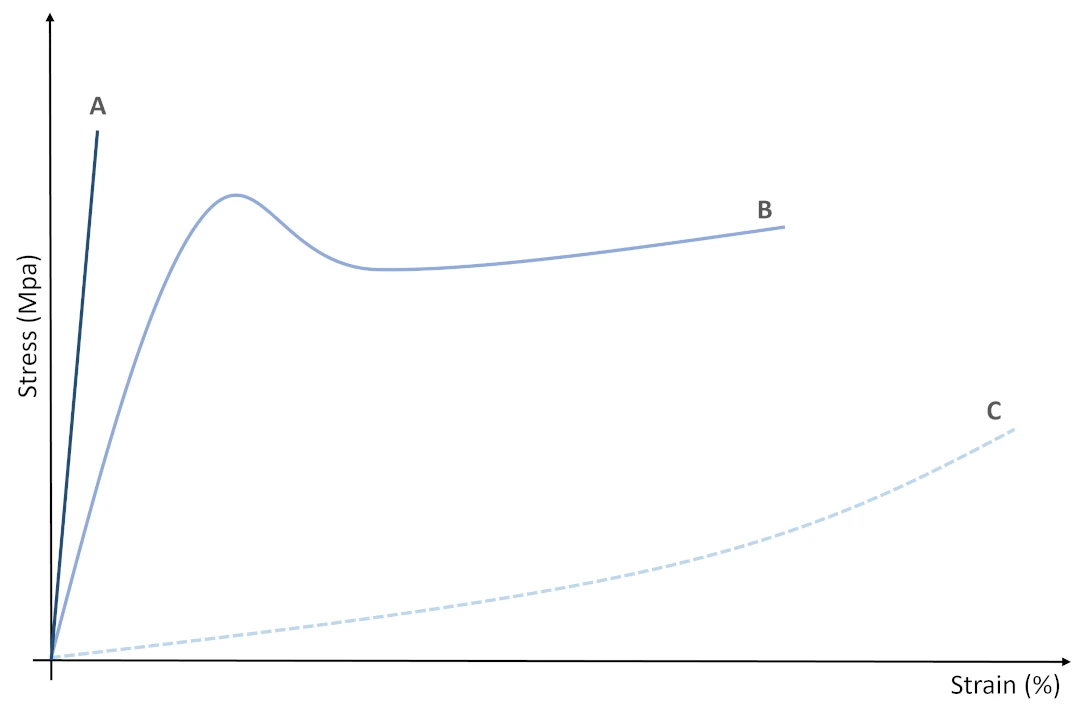
Figure 4 – Stress-strain curve for (a) fragile polymers, (b) plastics, (c) elastomers.
Tensile testing is equally important for polymer materials as it is for metals. It provides crucial information about the material’s mechanical properties, which can greatly vary based on the type of polymer, its formulation, and processing. Here are some common polymers and their typical tensile testing values:
- Polyethylene (PE): Polyethylene is one of the most widely used polymers. Its tensile strength can vary based on its density and molecular structure. Low-Density Polyethylene (LDPE) typically has a tensile strength of 8-17 MPa, while High-Density Polyethylene (HDPE) has a tensile strength of 20-33 MPa.
- Polypropylene (PP): Polypropylene is a versatile polymer used in a variety of applications from packaging to automotive components. Its tensile strength typically ranges from 25-35 MPa.
- Polyvinyl Chloride (PVC): PVC is a widely used thermoplastic with applications ranging from pipes to clothing. The tensile strength of rigid PVC can be up to 55 MPa, while flexible PVC typically has a tensile strength of 10-25 MPa.
- Polystyrene (PS): Polystyrene is a hard, brittle plastic that’s often used in disposable cutlery and CD cases. Its tensile strength is typically around 35-50 MPa.
- Polyethylene Terephthalate (PET): PET is commonly used in beverage bottles and other packaging applications. Its tensile strength typically ranges from 50-80 MPa.
- Polycarbonate (PC): Polycarbonate is a tough, transparent plastic often used in applications requiring good impact resistance, such as eyewear and electronic components. Its tensile strength typically ranges from 55-75 MPa.
- Polytetrafluoroethylene (PTFE/Teflon): PTFE is a high-performance polymer with a wide range of applications due to its unique properties, including high temperature resistance and low friction. Its tensile strength is typically around 20-35 MPa.
These are approximate values. The actual tensile strength can vary based on factors such as the specific formulation of the polymer, the manufacturing process, and any additives or fillers used in the material.
Tensile testing for Ceramic materials
Ceramic materials are generally a combination of metallic and non-metallic elements, usually oxides, nitrides and carbides. They are generally insulators of heat and electricity and are also more resistant to high temperatures and harsh environments than metals and polymers. Regarding the mechanical properties, ceramics are hard, but fragile.
Tensile testing is a critical method for determining the mechanical properties of ceramic materials. However, ceramics are often brittle and can be difficult to test under tensile loading due to their tendency to fracture at relatively low strains.
Therefore, indirect methods such as flexural testing or ring-on-ring tests are often used to estimate tensile strength. Here are some common ceramic materials and their typical tensile strength values:
- Alumina (Al2O3): Alumina is a widely used technical ceramic due to its good electrical insulation, high temperature resistance, and high hardness. The tensile strength of alumina ceramics typically ranges from 200-400 MPa.
- Zirconia (ZrO2): Zirconia ceramics, particularly those stabilized with yttria, are known for their high strength and toughness compared to other ceramics. The tensile strength of zirconia ceramics can range from 800-1000 MPa.
- Silicon Carbide (SiC): Silicon carbide is a very hard, high-temperature resistant ceramic with excellent thermal conductivity. Its tensile strength typically falls in the range of 300-500 MPa.
- Silicon Nitride (Si3N4): Silicon nitride ceramics are known for their high fracture toughness and thermal shock resistance. The tensile strength of silicon nitride ceramics can range from 500-800 MPa.
- Boron Carbide (B4C): Boron carbide is one of the hardest known materials and is often used in body armor and other applications requiring high hardness. Its tensile strength is typically around 300-400 MPa.
- Glass Ceramics: Glass ceramics, such as those used in cookware, have tensile strengths that can range from 50-100 MPa.
These are approximate values. The actual tensile strength can vary based on factors such as the specific formulation of the ceramic, the manufacturing process, and any additives or sintering aids used in the material.
Tensile testing for Composite materials
Composite materials are made from two or more constituent materials with significantly different physical or chemical properties. When combined, they produce a material with characteristics different from the individual components. The tensile strength of composite materials can vary widely depending on the types of materials used and their arrangement. Here are some common composite materials and their typical tensile strength values:
- Fiber-Reinforced Polymers (FRP): These are a type of composite material made of a polymer matrix reinforced with fibers. The fibers provide the strength and stiffness, while the matrix distributes the load evenly among the fibers. The tensile strength can vary widely depending on the type of fibers and matrix used. For example, carbon fiber composites can have tensile strengths up to 1500-2000 MPa, while glass fiber composites typically have tensile strengths in the range of 500-1000 MPa.
- Metal Matrix Composites (MMC): These are composites where a metal is reinforced with other metals, ceramics, or carbon fibers. The tensile strength of MMCs can range from 200-800 MPa depending on the materials used.
- Ceramic Matrix Composites (CMC): These are composites made of a ceramic matrix reinforced with fibers. They are designed to maintain their strength and toughness at high temperatures where metals may fail. The tensile strength of CMCs can range from 200-600 MPa.
- Concrete: Concrete is a composite material made of aggregate (gravel and sand) bonded together with cement. The tensile strength of concrete is much lower than its compressive strength, typically around 2-5 MPa.
- Wood: Wood is a natural composite material made of cellulose fibers bound together by a lignin matrix. The tensile strength of wood can vary based on the species and grain direction, but it typically ranges from 40-120 MPa.
These are approximate values. The actual tensile strength can vary based on factors such as the specific formulation of the composite, the manufacturing process, and the orientation of the reinforcement.
Tensile testing on Tensile Testing Machine
The tensile testing can be performed on a Tensile Testing Machine or Universal Testing Machine, which allows you to perform several types of mechanical tests. These machines used for the test can be hydraulic or electromechanical, and the electromechanical is based on an electric motor that allows greater control over speed variation and displacement of the mobile beam.
The claws guarantee the fixation and axial alignment of the specimens and the most common fixation systems are wedge, flange or thread. To plot the strain-strain graph, the applied force is measured instantly using a load cell, while the elongation is measured through the equipment’s encoder or by strain gauges. The equipment has software that allows the control and adjustment of the parameters and functions as well as the visualization of the test results allowing the generation of reports that can be saved on a computer connected to the equipment for further analysis.
It is worth remembering that the accuracy of a tensile test depends, of course, on the precision and quality of the equipment. The correct sizing of the equipment as well as the use of precise load cells accompanied by the use of an extensometer ensures the reliability of the test results.
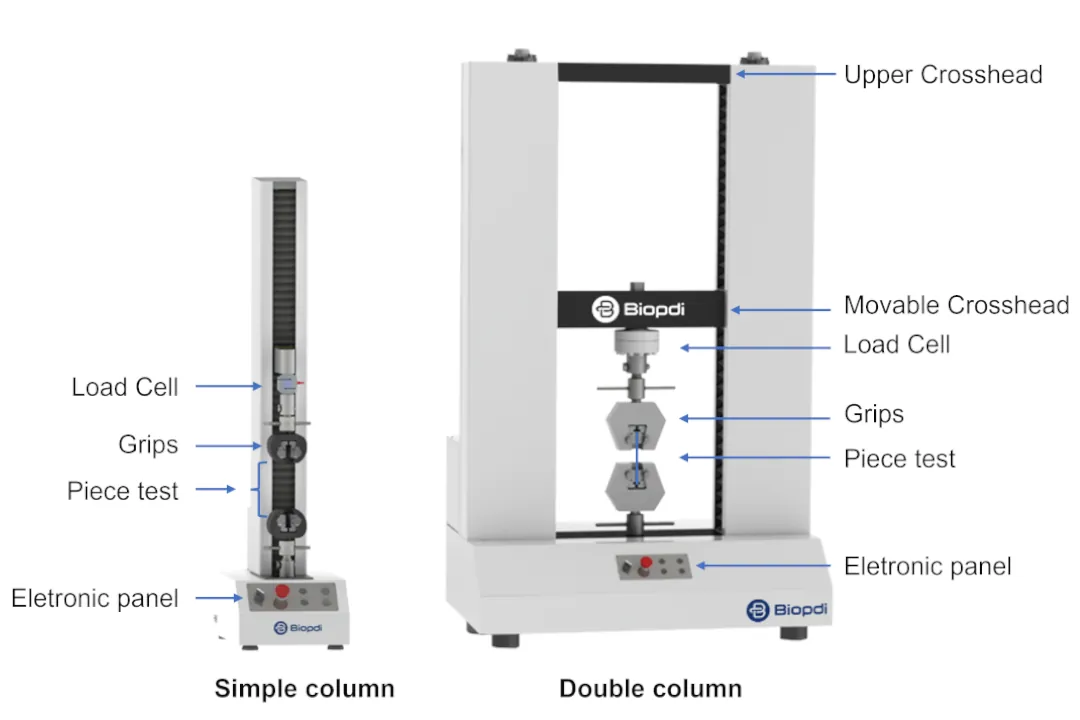
Figure 5 – Tensile Testing Machine: Single column and double column model
Specimen used to perform the tensile testing
The specimen used for tensile testing in a Testing Tenting Machine is typically a standardized sample of the material to be tested. The shape, size, and preparation of the specimen can vary depending on the material and the specific testing standards being followed. However, a common shape for tensile testing specimens is the “dog-bone” shape.
A “dog-bone” shaped specimen has a narrow, flat section in the middle with larger ends. The narrow section is where the material will fracture under tensile loading. This shape ensures that the stress is uniformly distributed in the middle section and that the fracture occurs away from the grips of the testing machine, providing more accurate results.
The dimensions of the specimen, including the length, width, and thickness of the narrow section, are determined by the testing standards. For example, ISO 6892 and ASTM E8, which is a common standard for tensile testing of metallic materials, specifies the dimensions for several types of “dog-bone” specimens.
Before testing, the specimen is often marked with gauge lines in the middle section. These lines are used to measure the change in length of the specimen during the test, which is needed to calculate strain.
The specimen is then mounted in the UTM, with the ends of the specimen secured in the machine’s grips. The machine applies a tensile load to the specimen, stretching it until it fractures. The force applied and the change in length of the specimen are recorded throughout the test, providing the data needed to calculate stress and strain and to determine the material’s mechanical properties.
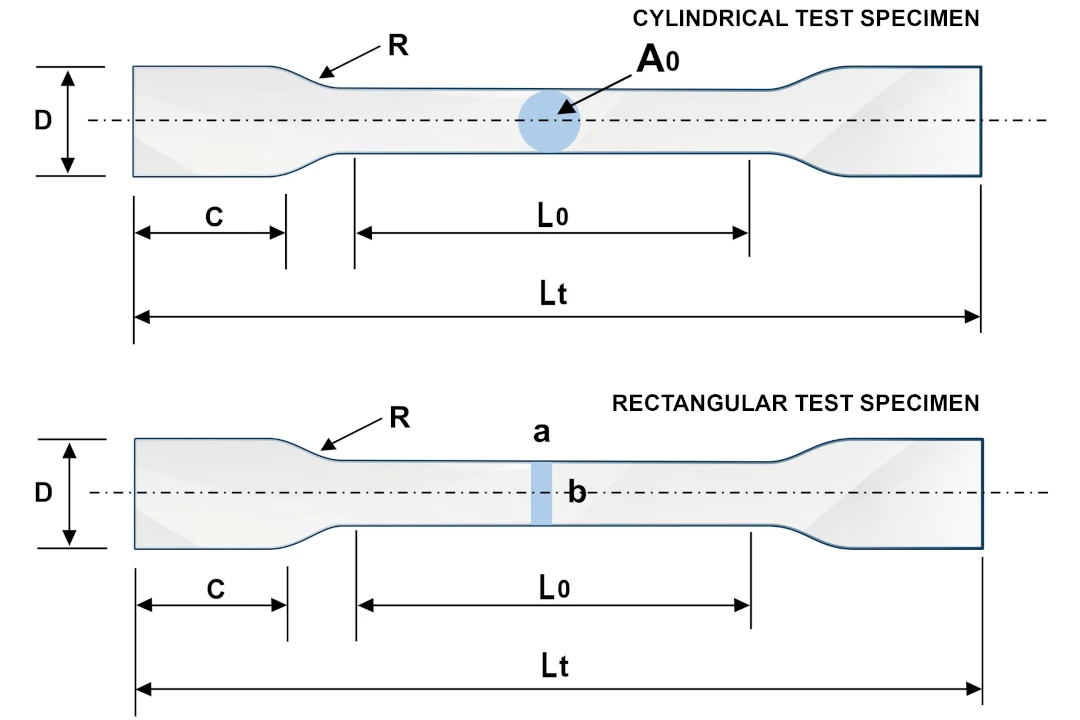
Figure 7 – Test specimens for tensile testing according to technical standard
Performing a tensile test using in Tensile Testing Machine
Performing a tensile test using a Tensile Testing Machine involves several steps. Here’s a general outline of the process:
- Sample Preparation: The first step in a tensile test is to prepare the sample. This usually involves cutting and shaping the material into a specific form, often a dog-bone shape, to ensure that the force is uniformly distributed during the test.
- Mounting the Sample: The sample is then mounted in the tensile testing machine. The machine has two clamps – one is stationary while the other can move. The sample is fixed at both ends to these clamps.
- Setting the Parameters: Using the UTM’s control unit, the operator sets the parameters for the test. This typically includes the rate at which the force will be applied and the maximum force or elongation that will end the test.
- Applying the Load: Once the sample is securely mounted, the tensile testing machine applies a controlled force to the sample. The moving clamp pulls the sample, stretching it and increasing the force gradually.
- Recording Data: As the force is applied, the machine measures and records the change in the sample’s length and the amount of force applied. This data is used to calculate stress and strain.
- Generating a Stress-Strain Curve: The recorded data is used to generate a stress-strain curve, which is a graph of the material’s response to the applied force. This curve provides valuable information about the material’s mechanical properties.
- Analyzing the Results: The final step is to analyze the results. This involves interpreting the stress-strain curve and calculating key properties such as the yield strength, ultimate tensile strength, and modulus of elasticity.
The exact procedure can vary depending on the type of material being tested and the specific requirements of the test. For example, some tests may be performed at specific temperatures or rates of strain. Always follow the relevant testing standards and guidelines to ensure accurate and reliable results.
The data obtained in the tensile testing using the Tensile Testing Machine
When performing a tensile test using a Tensile Testing Machine, several key pieces of data are obtained:
- Force vs. Displacement Data: The UTM records the force applied to the sample and the resulting displacement (change in length) of the sample throughout the test. This raw data can be used to calculate stress and strain.
- Stress-Strain Curve: The stress (force divided by original cross-sectional area) and strain (change in length divided by original length) are calculated and plotted against each other to create a stress-strain curve. This curve is a fundamental piece of data in materials science and can provide a wealth of information about the material’s mechanical properties.
From the stress-strain curve, several key properties can be determined:
- Elastic Modulus (Young’s Modulus): This is a measure of the stiffness of a material. It’s calculated as the slope of the initial, linear portion of the stress-strain curve.
- Yield Strength: This is the stress at which a material begins to deform plastically (permanently). It’s typically determined as the point at which the stress-strain curve deviates from linearity.
- Ultimate Tensile Strength: This is the maximum stress that a material can withstand. It’s determined as the maximum point on the stress-strain curve.
- Elongation at Break: This is a measure of the ductility of a material, or how much it can be deformed before breaking. It’s often expressed as a percentage increase in length and is determined from the strain at the maximum point on the stress-strain curve.
- Area Under the Curve: The area under the stress-strain curve can provide information about the toughness of the material, or its ability to absorb energy before breaking.
These data points provide a comprehensive overview of a material’s mechanical properties and behavior under tensile loading. They are crucial for material selection, design, quality control, and failure analysis in a wide range of industries.
Statistical treatment of the results in the tensile testing
Statistical treatment of results in tensile testing is crucial for understanding the reliability and variability of the measured properties. It involves analyzing multiple test results to determine mean values, standard deviations, and confidence intervals, among other statistical parameters. This analysis can provide insights into the consistency of the material’s properties and the precision of the testing procedure.
- Mean Values: The mean value of a property is calculated by adding up all the individual measurements and dividing by the number of measurements. This gives an average value that can be compared to the specifications given in relevant ISO or ASTM standards. For example, the mean tensile strength of a batch of steel samples can be compared to the minimum tensile strength specified in ASTM A36 for carbon structural steel.
- Standard Deviation: The standard deviation measures the spread of the data around the mean. A low standard deviation indicates that the data points are close to the mean, while a high standard deviation indicates that the data points are spread out over a wider range. ASTM E8/E8M, the standard for tensile testing of metallic materials, specifies that at least eight valid test results are needed to calculate a reliable standard deviation.
- Confidence Intervals: Confidence intervals provide a range within which the true population mean is likely to fall a certain percentage of the time (commonly 95% or 99%). They are a measure of the precision of the mean value. ISO 6892-1, the standard for tensile testing of metallic materials at room temperature, specifies procedures for calculating confidence intervals.
- Outliers: Outliers are data points that are significantly different from the others. They can result from measurement errors, specimen defects, or other anomalies. Both ISO and ASTM standards provide guidance on how to identify and handle outliers. For example, ASTM E178 describes standard practices for dealing with outliers in data from material testing.
- Comparison to Specifications: Once the statistical parameters have been calculated, they can be compared to the specifications given in relevant ISO or ASTM standards. If the mean values fall within the specified ranges and the standard deviations are acceptable, the material can be considered to meet the standard.
Statistical treatment of tensile test results provides a more complete understanding of the material’s properties and the reliability of the testing procedure. It’s an essential part of ensuring that materials meet the requirements of relevant ISO and ASTM standards.
Tensile testing Standards
When it comes to carrying out mechanical tests, the most used standards are those referring to the specification of materials and the test method. One method describes the correct procedure to carry out a given mechanical test.
Thus, following the same method, the results obtained for the same material are similar and reproducible wherever the test is performed. Some examples of technical standards used by testing laboratories are:
Metallic materials
Here are some of the main standards used in tensile testing on metallic materials:
- ISO 6892-1: This standard specifies the method for tensile testing of metallic materials and defines the mechanical properties that can be determined at room temperature.
- ISO 10113: This standard specifies a method for determining the plastic strain ratio of flat products of steel.
- ISO 10275: This standard specifies the method for tensile testing of metallic sheets and strips which are of thickness less than 6 mm and which are used for the construction of cans, closures, and other formed parts.
- ISO 15630-1: This standard specifies test methods applicable to steel for the reinforcement of concrete in terms of tensile test, ribbed wire, and welded fabric.
- ASTM E8 / E8M: This is the standard test method for tension testing of metallic materials. It covers the procedure for testing the tensile properties of metallic materials in any form at room temperature, specifically the methods of determination of yield strength, yield point elongation, tensile strength, elongation, and reduction of area.
- ASTM A370: This standard test method and definitions for mechanical testing of steel products.
- ASTM B557: This standard covers tension testing of wrought and cast aluminum- and magnesium-alloy products.
- ASTM E345: This standard covers the determination of the axial load that can be sustained by a metallic material under conditions of constant strain rate.
- ASTM E21: This standard covers the determination of the strength of metals subjected to tensile forces at elevated temperatures.
- ASTM E517: This standard covers the determination of the plastic strain ratio of sheet metal specimens.
Polymer materials
Here are some of the main standards used in tensile testing on polymer materials:
- ISO 527-1: This standard specifies the general principles for determining the tensile properties of plastics and plastic composites under defined conditions.
- ISO 527-2: This part of ISO 527 specifies the test conditions for the determination of the tensile properties of plastic films and sheets less than 1 mm thick.
- ISO 527-3: This part of ISO 527 specifies the test conditions for the determination of tensile properties of moulding and extrusion plastics based on multiphase systems, such as filled or reinforced compounds.
- ISO 37: This standard specifies a method for the determination of the tensile stress-strain properties of vulcanized and thermoplastic rubbers.
- ISO 1926: This standard specifies a method for the determination of the tensile properties of flexible cellular materials.
- ASTM D638: This is the standard test method for tensile properties of plastics. It covers the determination of tensile properties of unreinforced and reinforced plastics in the form of standard dumbbell-shaped test specimens.
- ASTM D882: This standard test method for tensile properties of thin plastic sheeting. It covers the determination of tensile properties of plastics in the form of thin sheeting and films (less than 1.0 mm (0.04 in.) in thickness).
- ASTM D1708: This standard covers the determination of comparative tensile strength and elongation properties of plastics in the microtensile form.
- ASTM D412: This standard covers procedures used to test rubber and elastomers. It includes test methods for determining tension, elongation, set, and set under constant elongation.
- ASTM D3039 / D3039M: This standard test method for tensile properties of polymer matrix composite materials.
Composite materials
Here are some of the main standards used in tensile testing on composite materials:
- ISO 13003: This standard specifies a method for determining the tensile properties of fiber-reinforced plastic composites by using a split-disk test specimen.
- ISO 1922: This standard specifies a method for the determination of the tensile properties of flexible cellular materials.
- ISO 14129: This standard specifies the methods for determining the tensile properties of ceramic matrix composite materials reinforced with continuous fibers.
- ISO 527-5: This standards test methods for determination of tensile properties and test conditions for unidirectional fibre-reinforced plastic composites.
- ASTM D7267 / D7267M: This standard test method covers the determination of tensile properties of sandwich constructions.
- ASTM D5450 / D5450M: This standard test method covers the determination of transverse tensile properties of hoop wound polymer matrix composite materials.
- ASTM D3518 / D3518M: This standard test method covers the determination of in-plane shear response of polymer matrix composite materials reinforced by high-modulus fibers.
- ASTM D3039 / D3039M: This is the standard test method for tensile properties of polymer matrix composite materials. It covers the determination of the in-plane tensile properties of polymer matrix composite materials reinforced by high-modulus fibers.
- ASTM D5766 / D5766M: This standard test method covers the determination of the tensile properties of polymer matrix composites using a combined loading compression (CLC) test fixture.
- ASTM D198: This standard test methods of static tests of lumber in structural sizes.
Extensometer usage during the tensile testing
In the test conducted without the use of the extensometer, the increase in the length of the sample is measured by the movable crosshead of the Tensile testing machine, which includes elastic deformations and the accommodation of the entire system (machine, sample, load cell, and fixing elements).
The measurements in the elastic deformation region of the curve are significantly affected and represent properties of the material + system set. However, for large deformations (regions of uniform and non-uniform plastic deformation of the tensile curve), the effect of the system’s deformations tends to be minimized in relation to the deformation of the sample.
In contrast, in the test with the use of the extensometer, the measuring instrument is attached to the specimen. It exclusively measures the deformations that occur in the material within a reference length, thus excluding the effects of deformation of the machine and the grips.
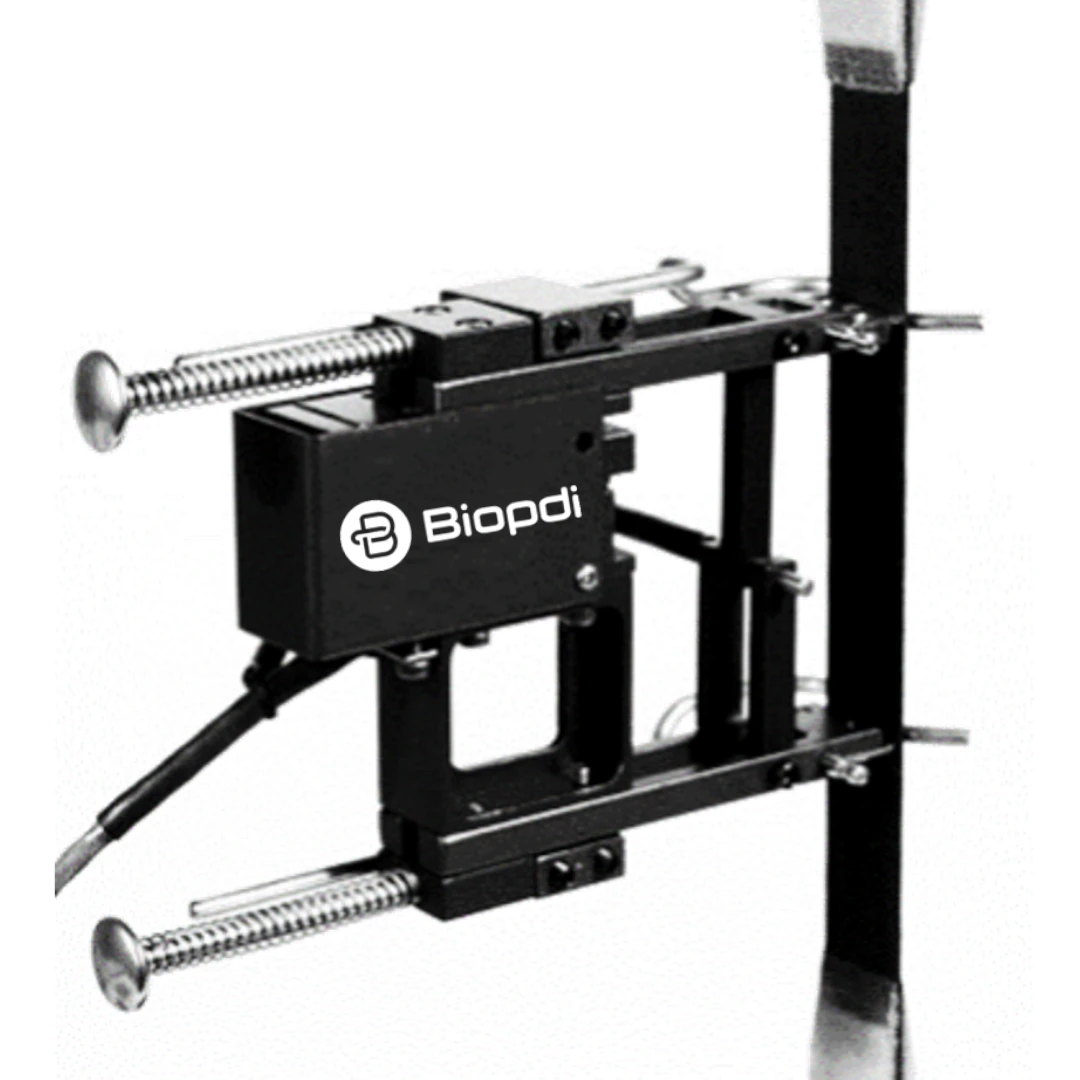
Figure 8 – Typical extensometer used in tensile testing
Extensometry is essential to obtain accurate properties in the elastic region of the curve, such as the limits of elasticity and proportionality, as well as the modules of elasticity and resilience. Additionally, utilizing the extensometer enables greater precision in determining the conventional yield limit.
In the stress-strain curve of aluminum below, two measurements were taken: the black graph represents the results without the use of the extensometer, while the red graph represents the results with the extensometer in use. For the Young’s modulus, a value of 71.4 GPa was obtained in both cases, i.e., with and without the extensometer. However, significantly higher values were observed for the resistance limit and elongation when the extensometer was not used.
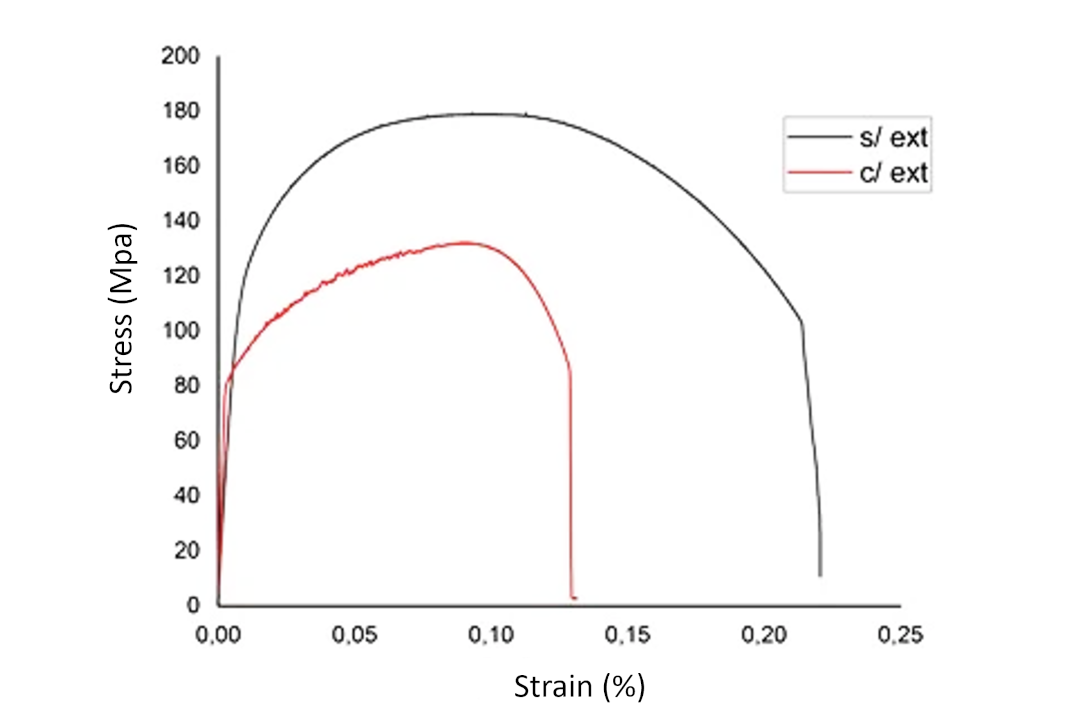
Figure 9 – Stress-strain curve of aluminum with and without the use of an extensometer
Considerations on the results of the tensile testing
Tensile testing is a critical method for assessing the mechanical properties of a material, but it’s important to remember that the results can be influenced by a variety of factors. Here are some considerations on how these factors can affect the results of tensile testing:
- Test Execution Temperature: The temperature at which a tensile test is performed can significantly impact the material’s behavior. For instance, metals often become more brittle at low temperatures and more ductile at high temperatures. Therefore, a material tested at room temperature may exhibit different properties than the same material tested at an elevated or reduced temperature. It’s crucial to control and record the temperature during testing to ensure accurate and repeatable results.
- Alloy Solute Content: The composition of an alloy, particularly the amount and type of solute elements, can greatly affect its mechanical properties. For example, adding carbon to iron creates steel, which has significantly different tensile properties than pure iron. Different types or amounts of solute can alter the strength, ductility, and other properties of an alloy, so it’s important to know the exact composition of the material being tested.
- Thermal and Mechanical Treatments: The history of a material, including any thermal treatments (like heat treating or annealing) or mechanical treatments (like work hardening or cold rolling), can change its microstructure and, therefore, its mechanical properties. For instance, heat treatment can increase the hardness and strength of steel, while work hardening can increase the strength of aluminum. Any prior treatments should be noted and considered when interpreting tensile test results.
- Material Grain Size: The grain size of a material can influence its mechanical properties. In general, materials with smaller grains are stronger but less ductile, while materials with larger grains are more ductile but less strong. This is known as the Hall-Petch relationship. The grain size can be controlled through processes like heat treatment and can be characterized using techniques like microscopy.
Tensile testing provides valuable information about a material’s mechanical properties, it’s important to consider the context in which the material will be used and the factors that might influence its behavior under different conditions. Always consider the testing conditions and the material’s history and composition when interpreting tensile test results.
Conclusion
Tensile testing is a critical procedure that allows us to understand the mechanical properties of various materials, including their ductile or brittle behavior and any potential flaws in their composition. This knowledge is crucial in determining the appropriate applications for each material.
When embarking on a project, it’s essential to consider the tensile strength of the materials involved. Understanding whether the load applied at a specific point is suitable can be determined through tensile testing. The results of these tests provide the necessary data to answer these vital questions, ensuring the safety and success of your project or application.
Utilizing a Tensile Testing Machine, tensile testing offers invaluable insights in the field of materials science and engineering. It enables us to predict how materials will respond under tensile stress, a key factor in material selection, quality control, research and development, and failure analysis. Adhering to various ISO and ASTM standards, tensile testing can be applied to a broad spectrum of materials, such as metals, polymers, ceramics, and composites.
Through a comprehensive understanding of tensile testing, we can guarantee the reliability and safety of materials across a multitude of applications, spanning from construction and transportation to electronics and medical devices.
FAQ
Where is tensile testing used?
Tensile testing is used across various industries including construction, automotive, aerospace, medical devices, electronics, and materials manufacturing, among others.
What are the requirements for a tensile test?
A tensile test requires a standardized specimen of the material, a testing machine capable of applying a controlled force, and a method for measuring the change in the specimen’s length and the applied force.
Why do we use tensile testing?
We use tensile testing to determine the mechanical properties of a material, such as its strength, ductility, and elasticity. This information is crucial for material selection, quality control, and predicting how a material will behave under stress.
What is tensile vs compressive test?
Tensile testing involves applying a pulling force to a material until it breaks, while compressive testing involves applying a pushing force that compresses the material until it deforms or breaks.
What is the most common tensile test?
The most common tensile test is the one performed on a “dog-bone” shaped specimen using a Tensile Testing Machine. This test is governed by standards such as ASTM E8 for metals and ASTM D638 for plastics.
How do you measure tensile strength?
Tensile strength is measured by dividing the maximum force applied during the test by the original cross-sectional area of the specimen.
What is the tensile test for steel?
The tensile test for steel involves applying a tensile force to a standardized steel specimen until it fractures. The results are used to calculate properties such as the yield strength, ultimate tensile strength, and elongation.
What is the purpose of tensile strength?
The purpose of tensile strength is to provide a measure of a material’s resistance to being pulled apart. It’s a key property for materials used in applications where tensile stresses are encountered.
Does high tensile strength mean strong?
High tensile strength generally means a material is strong in tension, i.e., it can withstand a high amount of force without breaking when being pulled apart.
What is tensile strength for dummies?
Tensile strength is a measure of how much pulling force a material can withstand before breaking. It’s like a tug-of-war: the stronger team (material with higher tensile strength) can withstand more pulling force.
What is tensile strength in simple words?
Tensile strength is the maximum amount of force a material can withstand without breaking when being pulled apart.
What material has low tensile strength?
Materials like rubber, certain plastics, and soft metals like lead typically have low tensile strength.
What material has the highest tensile strength?
As of my knowledge cutoff in September 2021, graphene, a single layer of carbon atoms arranged in a two-dimensional honeycomb lattice, has the highest tensile strength of any known material.
What is tensile strength in PSI?
Tensile strength in PSI (pounds per square inch) is a common unit used in the US customary units system. It’s the force in pounds needed to break a material divided by the material’s cross-sectional area in square inches.
What are the three different ways tensile strength is measured?
Tensile strength can be measured using a direct method (like a tensile test), an indirect method (like a hardness test), or by non-destructive testing methods (like ultrasonic testing).
How do you manually test tensile strength?
Manual testing of tensile strength is typically not recommended due to the difficulty in applying a controlled force and accurately measuring the material’s response. However, simple experiments using weights and measuring deformation can give a rough estimate.
Which is more important yield strength or tensile strength?
Both are important and serve different purposes. Yield strength is the stress at which a material begins to deform plastically and is important in designing structures that will not deform under load. Tensile strength is the maximum stress a material can withstand and is important in applications where a material must resist breaking under tension.
What are the typical material and standards used in a tensile test?
Typical materials tested include metals, plastics, composites, and ceramics. Common standards include ASTM E8 for metals, ASTM D638 for plastics, and ISO 527 for plastics.
What specimen shape is used in tensile test?
A “dog-bone” shaped specimen is commonly used in tensile testing to ensure that the material fails in the middle of the sample, away from the grips of the testing machine.
What is the typical configuration for a tensile test?
The typical configuration involves mounting the specimen in the grips of a testing machine, applying a controlled force that stretches the specimen, and measuring the force and the specimen’s change in length.
What Grip and Face should I use in a tensile test?
The choice of grip and face depends on the material and the specific testing standard. For example, serrated jaw faces are often used for metals, while rubber-coated or flat jaw faces are used for softer materials or thin films.
How do I align my specimen in a tensile test?
The specimen should be aligned so that the force is applied evenly along the axis of the specimen. Misalignment can cause bending and lead to inaccurate results. Some testing machines have self-aligning grips to help ensure proper alignment.
See more relevant posts
TENSILE TEST
Tensile testing is a crucial mechanical test used to evaluate the strength and ductility of materials. It involves applying a controlled force. See more
COMPRESSION TEST
Compression testing is a fundamental evaluation method employed to assess a material's ability to withstand compressive forces. See more
SHEAR TEST
Shear testing examines a material's response to forces acting parallel to its surface. By applying a force that causes one part of the material. See more
BEND TEST
Bend testing is a mechanical test that determines a material's flexibility and resistance to fracture under bending forces. See more
FLEXURAL TEST
Flexural testing, also known as the three-point bend test, is employed to measure a material's resistance to bending or flexural stress. See more
FRICTION TEST
Coefficient of friction test measures the amount of resistance between two surfaces in contact when one moves relative to the other. See more
TEAR TEST
Tear test determines a material's resistance to tearing forces, often encountered in applications involving thin films, fabrics. See more
PEEL TEST
Peel testing evaluates the strength of adhesion between two materials, typically an adhesive and a substrate. The test involves separating. See more
BOND TEST
Bond test measures the strength of a bond between two materials. It's used in adhesive and weld test. It helps in determining the reliability of joints and interfaces. See more
INDENTATION TEST
Indentation Force Deflection (IFD) is used to characterize the cushioning or compressive properties of a material, especially foams and soft polymers. See more
FRACTURE TEST
Fracture toughness is a material's ability to resist crack propagation. This property is vital for assessing a material's suitability for applications where structural. See more
PUNCTURE TEST
Puncture test examines a material's ability to withstand penetration by sharp objects or forces. This test to evaluate puncture strength and design materials. See more
CRUSH TEST
Crush resistance test measures a material's ability to resist deformation, particularly in terms of compressive force. See more
TORSION TEST
Torsion testing is a critical method in materials engineering, examining how products and materials behave under twisting forces. See more
AXIAL TORSION TEST
Axial torsion test examines a material's behavior when subjected to simultaneous axial and torsional loads. This test to study shear stress. See more
FATIGUE TEST
Fatigue Testing is the evaluation of a material's endurance and failure under repeated stress and cyclic loading conditions. See more.

Author: Mardoqueu M. Costa (Entrepreneur, researcher and writer). I have been working for several years in materials science and engineering and biomedical engineering with emphasis on Entrepreneurship. My focus is on the development of equipment, software, mechanical tests, and the evaluation and creation of new businesses. As a researcher and writer, I have contributed to scientific publications and patents, also working as a technical-scientific consultant for several companies. This integrated approach reflects my commitment to innovation and impact in the technology industry.
Contact us
Phones:
+1 (781) 328 - 2010
sales@biopdi.com
Address:
2 Burlington Woods Dr, Burlington, Massachusetts, United States


